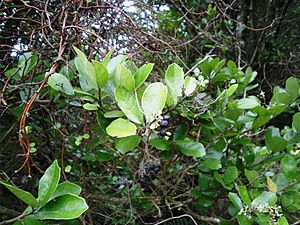Kaikomako facts for kids
Quick facts for kids Kaikomako |
|
|---|---|
 |
|
| A close-up of Kaikomako flowers | |
| Scientific classification | |
| Genus: |
Pennantia
|
| Species: |
corymbosa
|
The kaikomako (scientific name: Pennantia corymbosa) is a small forest tree found only in New Zealand. Its Māori name, kaikōmako, means "food of the bellbird." This tree is special because it has separate male and female plants, which is called being dioecious.
Contents
What is Kaikomako?
Kaikomako trees grow small, creamy-white flowers. These flowers appear between November and February. After the flowers, shiny black fruits grow in autumn. These fruits are a favorite snack for the New Zealand bellbird, a native bird.
The Meaning of its Name
The Māori name kaikōmako tells us something important about the tree. The word kai means "food," and kōmako is the Māori name for the bellbird. So, the name literally means "food of the bellbird."
Traditional Uses
Long ago, the Māori people used the kaikomako tree in a very clever way. They would rub a pointed stick made from kaikomako into a groove on a piece of mahoe wood. This rubbing created enough heat to start a fire.
Growing Up: From Duck's Foot to Tree
Kaikomako trees look quite different when they are young compared to when they are fully grown.
The "Duck's Foot" Stage
When a kaikomako plant is young, its leaves have a unique shape. This shape looks a bit like a duck's foot, which is why it sometimes gets the English name "duck's foot." Young plants also have many small leaves and tangled, spreading stems. This spreading growth pattern is called "divaricating." It means the branches grow in many directions, often crossing over each other.
The Mature Tree
As the kaikomako grows older, it changes a lot. The leaves become much larger than those on the young plant. The tree also develops a more typical tree shape, with a clear trunk and branches that grow outwards in a more usual way.
Reproduction and Life Cycle
Kaikomako trees are dioecious. This means that individual trees are either male or female.
Male and Female Plants
Male kaikomako trees produce flowers that have pollen. Female kaikomako trees produce flowers that can develop into fruit after being pollinated. For the tree to make seeds and fruit, pollen from a male tree needs to reach the flowers of a female tree. This is often done by insects or the wind.


